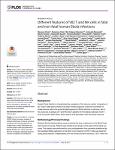Different features of Vδ2 T and NK cells in fatal and non-fatal human Ebola infections
Cimini, Eleonora
Viola, Domenico
Cabeza-Cabrerizo, Mar
Romanelli, Antonella
Tumino, Nicola
Sacchi, Alessandra
Bordoni, Veronica
Casetti, Rita
Turchi, Federica
Martini, Federico
Bore, Joseph A.
Koundouno, Fara Raymond
Duraffour, Sophie
Michel, Janine
Holm, Tobias
Zekeng, Elsa Gayle
Cowley, Lauren
Dorival, Isabel Garcia
Doerrbecker, Juliane
Hetzelt, Nicole
Baum, Jonathan H. J.
Portmann, Jasmine
Muñoz-Fontela, César
Agrati, Chiara
Background: Human Ebola infection is characterized by a paralysis of the immune system. A signature of αβ T cells in fatal Ebola infection has been recently proposed, while the involvement of innate immune cells in the protection/pathogenesis of Ebola infection is unknown. Aim of this study was to analyze γδ T and NK cells in patients from the Ebola outbreak of 2014–2015 occurred in West Africa, and to assess their association with the clinical outcome. Methodology/Principal findings: Nineteen Ebola-infected patients were enrolled at the time of admission to the Ebola Treatment Centre in Guinea. Patients were divided in two groups on the basis of the clinical outcome. The analysis was performed by using multiparametric flow cytometry established by the European Mobile Laboratory in the field. A low frequency of Vδ2 T-cells was observed during Ebola infection, independently from the clinical outcome. Moreover, Vδ2 T-cells from Ebola patients massively expressed CD95 apoptotic marker, suggesting the involvement of apoptotic mechanisms in Vδ2 T-cell loss. Interestingly, Vδ2 T-cells from survivors expressed an effector phenotype and presented a lower expression of the CTLA-4 exhaustion marker than fatalities, suggesting a role of effector Vδ2 T-cells in the protection. Furthermore, patients with fatal Ebola infection were characterized by a lower NK cell frequency than patients with non fatal infection. In particular, both CD56bright and CD56dim NK frequency were very low both in fatal and non fatal infections, while a higher frequency of CD56neg NK cells was associated to non-fatal infections. Finally, NK activation and expression of NKp46 and CD158a were independent from clinical outcome. Conclusions/Significances: Altogether, the data suggest that both effector Vδ2 T-cells and NK cells may play a role in the complex network of protective response to EBOV infection. Further studies are required to characterize the protective effector functions of Vδ2 and NK cells.
No license information

